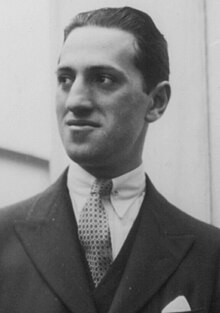George Gershwin
| Born |
Jacob Gershwine
September 26, 1898 New York City, U.S.
|
|---|---|
| Died | July 11, 1937 (aged 38)
Los Angeles, California, U.S.
|
| Resting place | Westchester Hills Cemetery, New York |
| Occupations |
|
| Years active | 1916–1937 |
| Relatives |
|
George Gershwin (/ˈɡɜːrʃ.wɪn/; born Jacob Gershwine; September 26, 1898 – July 11, 1937) was an American composer and pianist whose compositions spanned popular, jazz and classical genres. Among his best-known works are the orchestral compositions Rhapsody in Blue (1924) and An American in Paris (1928), the songs “Swanee” (1919) and “Fascinating Rhythm” (1924), the jazz standards “Embraceable You” (1928) and “I Got Rhythm” (1930), and the opera Porgy and Bess (1935), which included the hit “Summertime”.
See More :

It came as a surprise for George Gershwin’s parents that he had secretly been learning to play the piano they had bought for his older brother Ira. The acclaimed piano teacher Charles Hambitzer took the boy on and soon wrote to his sister: ‘I have a new pupil who will make his mark if anybody will. The boy is a genius.”
Gershwin began his career as a song plugger and worked as a rehearsal pianist for Broadway singers. In 1916 he published his first song, ‘When You Want ’Em You Can’t Get ’Em’, but his first big hit was ‘Swanee’, recorded by the singer Al Jolson, which sold a million sheet music copies, and an estimated two million records. Gershwin started composing Broadway musical theatre works with his brother Ira writing the lyrics. Together, they wrote several hit musicals like Lady Be Good, Oh, Kay!, Funny Face, Strike Up the Band, Show Girl, and Girl Crazy.
In January 1924, Gershwin reportedly learned from a newspaper article that he was meant to be writing a ‘jazz concerto’ for a program of new American music to be given a month later. Writing at a manic pace, Gershwin composed a two-piano version, which was then orchestrated by Ferde Grofé. Rhapsody in Blue, with Gershwin as soloist, was a triumph – today it is hailed as a landmark in American music. One year on from Rhapsody in Blue, Gershwin extended his innovative jazz-influenced classical style even further with his Piano Concerto.
Gershwin stayed in Paris for a short period in the mid-1920s. He was intrigued by the modernist works of Berg, Shostakovich, Stravinsky, Milhaud, and Schoenberg and asked several high-profile composers for lessons: Nadia Boulanger, Maurice Ravel, and Arnold Schönberg. They all rejected him, afraid of ruining his jazz-influenced style. Schoenberg reportedly said: ‘I would only make you a bad Schoenberg, and you’re such a good Gershwin already.’ However, Schoenberg enjoyed playing tennis with Gershwin once a week!
Gershwin’s most ambitious composition was the ‘folk opera’ Porgy and Bess, which contains some huge hit arias – ‘Summertime’, ‘I Got Plenty o’ Nuttin’’ and ‘It Ain’t Necessarily So’. It was a box office flop when first performed in 1935, but is now widely regarded as one of the most important American operas. Gershwin also spent time in Hollywood and worked on many film scores, such as Shall We Dance, starring Fred Astaire and Ginger Rogers, which married ballet with jazz in a new way.
In 1937, Gershwin was diagnosed with a brain tumor. Doctors tried to operate but unfortunately to no avail – Gershwin died on 11 July at the age of 38.
| Title | Key | Year | Level | |
|---|---|---|---|---|
All pieces: |
||||
| Rhapsody in Blue – Two Piano Version | B-flat Major | 1924 | 8+ | |
| Rhapsody in Blue – Solo Piano Version | B-flat Major | 1924 | 8+ | |
Copy by : pianosintheparks.com



Leave a Reply
Want to join the discussion?Feel free to contribute!